NOLA
A walk through the French Quarter
This project is a fast-paced, color-soaked walk through the French Quarter—one of the most electric, unpredictable, and visually overloaded places I’ve ever experienced. It’s not quiet here. The streets sing. The walls talk. Every corner is alive with performers, poets, vendors, tourists, and characters who feel like they were born to stand out. But in all that energy, people can get lost in the noise.
So I decided to pull them out.
In almost every image, I stripped the people to black and white—stripped of distraction, stripped to their essence—and left the city in full, unapologetic color. It’s not just about contrast. It’s about clarity. This city makes people come alive in a bright, visual kind of way. I wanted the viewer to feel that—to feel the separation, the collision, the heartbeat between people and place. The colors are saturated because New Orleans is saturated. It doesn’t whisper—it hollers, celebrates, and performs. And when you put people against that kind of backdrop, sometimes you have to strip away the color just to see the soul.
The images I left in full color—the transition moments—are the breath between beats. They’re about movement, momentum. They show people and place shifting from one moment to the next, guiding the viewer forward. They aren’t breaks from the story—they are the story’s rhythm. These are the moments in between, where the city and its people keep flowing together.
And that’s the thing: to visit the French Quarter and leave unchanged? Not a chance. This place grabs you. It lingers. It pushes you to pay attention. That’s what I wanted this project to do. I didn’t interview anyone. I didn’t pose a single shot. But the faces, the moments, the way people exist inside this visual storm—it all tells a story. You just have to slow down and see it.
NOLA is about movement, presence, and contrast. It’s about pulling moments out of the chaos and holding them still, just long enough to be felt.

It starts here, on Bourbon—where the air hums with music, clinks of glasses echo off balconies, and voices rise in bursts like brass. The colors are loud. The signs are louder. It’s easy to get swept up in it all, but if you stop for a second, you start to see the rhythm underneath. This is the French Quarter’s first impression: unfiltered, electric, and impossible to ignore.
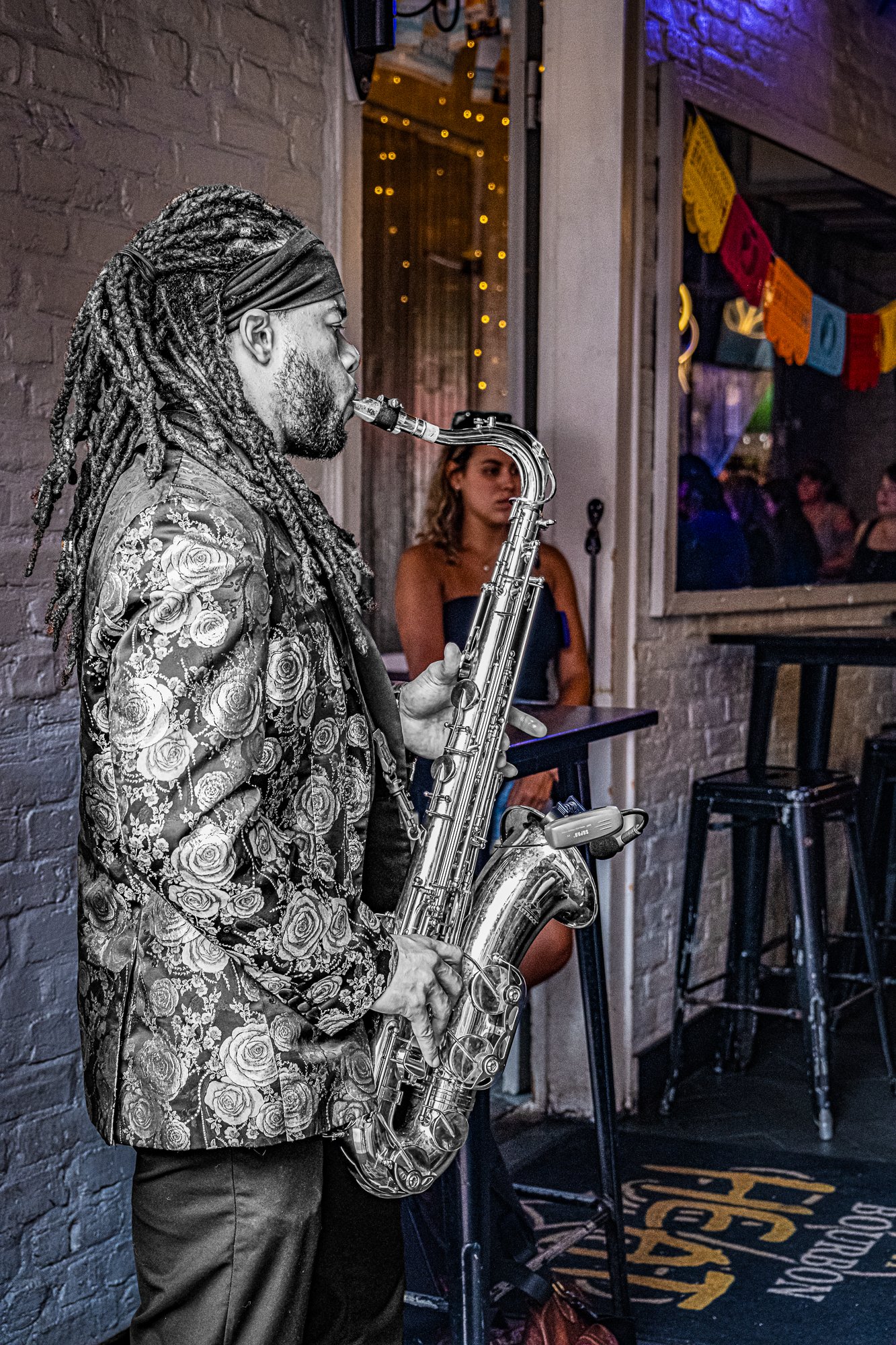
Just inside the entrance of a bar, a saxophonist stands playing, hoping his sound will spill into the street and draw people in. He plays with purpose—every note a pitch for attention, every glance toward the sidewalk a quiet ask. He’s performing for whoever’s listening, but really, he’s aiming for those still deciding whether to stop.
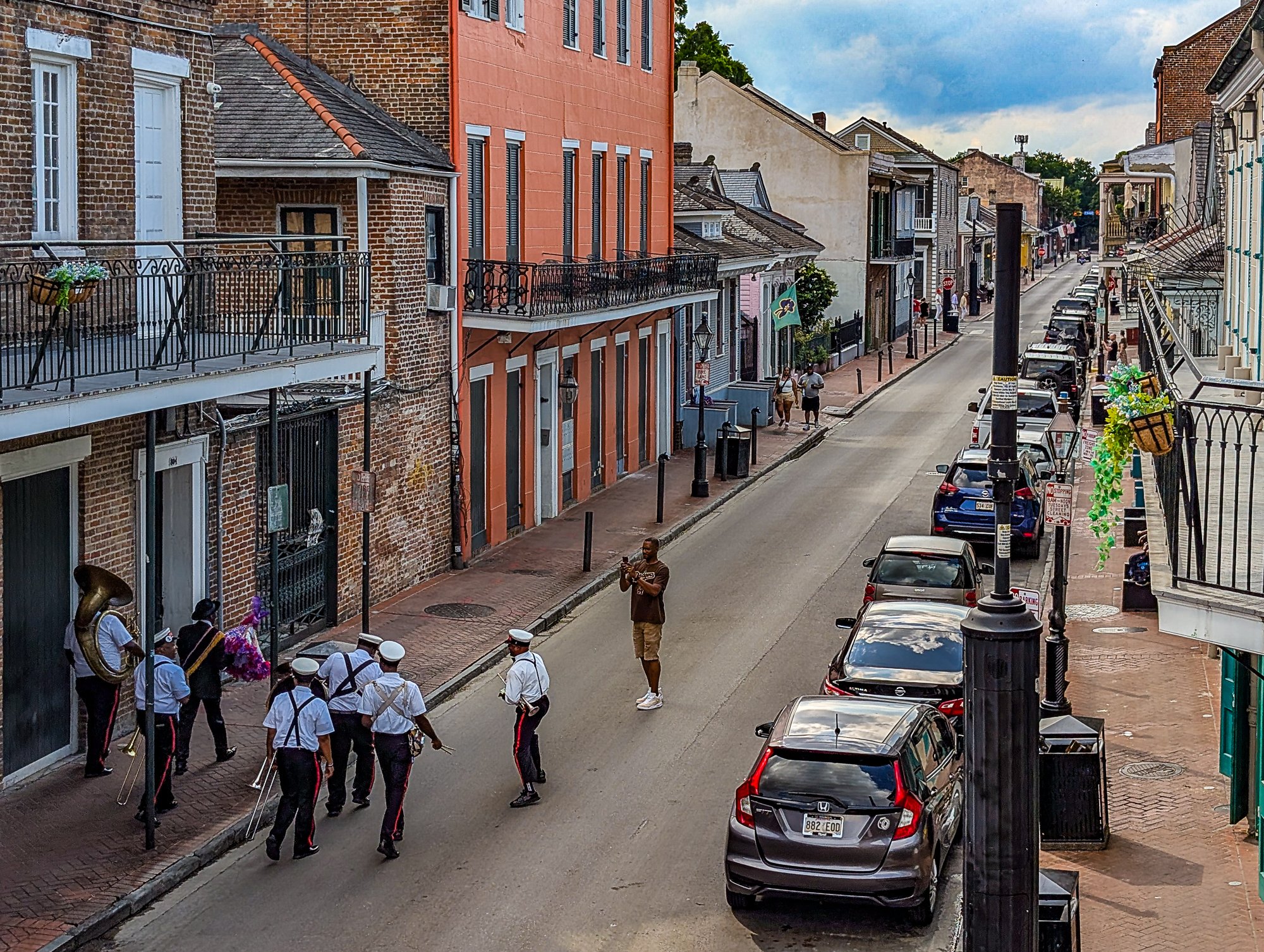
It’s midday on a Saturday, and Bourbon Street has thinned out. But the band doesn’t care. They’re singing, dancing, and grooving down the block like they’re leading a second line. No audience? No problem. They’re their own celebration—moving toward Royal, drawing you forward, carrying the promise that something better is just a few blocks ahead.

On Royal Street, a guitarist plays to no one in particular. No stage, no crowd—just open chords drifting through the warm air. His sound is soulful, deliberate, the kind you only hear when you’re not in a rush. There’s something grounding about him, like he’s holding still while everything else moves. If you stop, the music finds you.
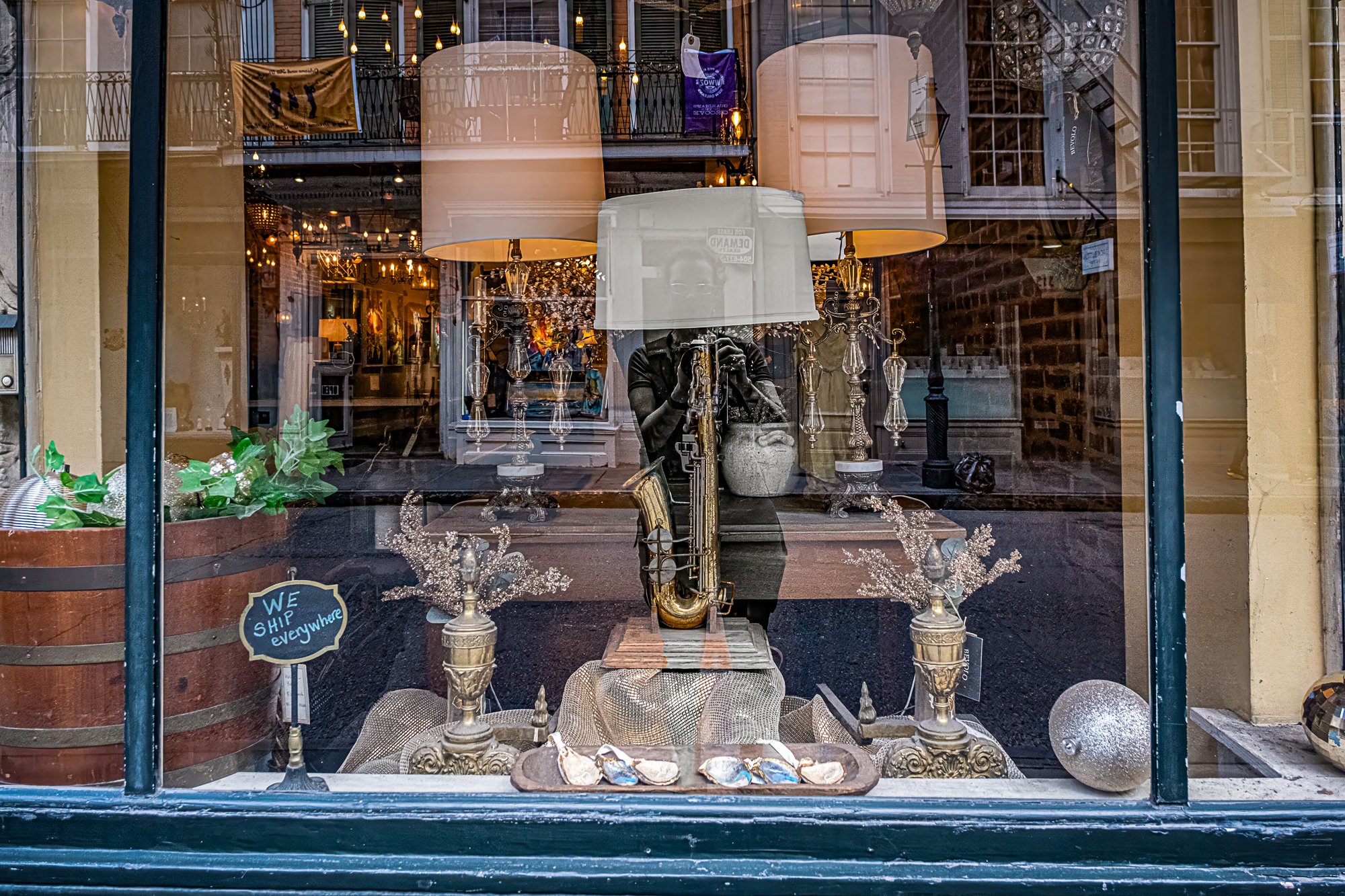
A few doors down, I catch a glimpse of myself—reflected in a window, camera up, mid-step, not posing, just observing. That frame reminded me this isn’t just a walk through other people’s stories—I’m in it too. I came to see the city, but the city saw me back. For a second, it all folds together: the rhythm, the color, and me, trying to hold it in a frame.

From Royal, we move toward Jackson Square. The energy shifts. The Cathedral rises ahead—spires cutting into the sky like it’s seen it all before. Carriages wait nearby, lined in a row, their drivers ready with practiced stories. Around the square, artists and performers gather. It feels more open here—more spacious, like the Quarter stretching out its arms.
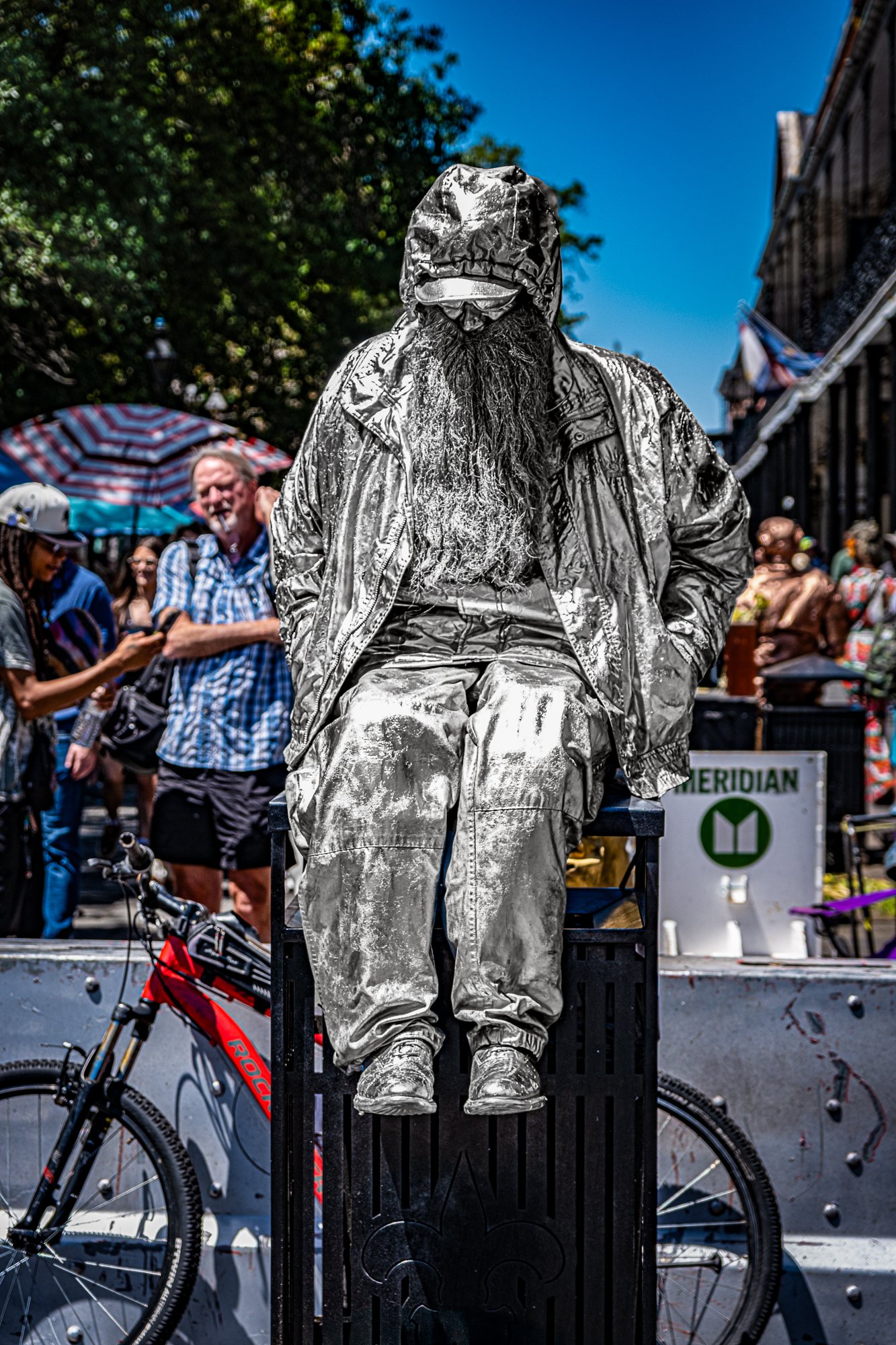
Just beyond the carriages and cathedral steps, a silver figure stands frozen—face painted, arms steady, unmoving in the heat. A living statue. Or maybe not. Is it a man beneath the paint? That’s part of the magic. You’ll have to look closely, and even then, you might not be sure. In a city full of spectacle, this quiet, motionless figure will really make you stop—and wonder.

Near the fence at Jackson Square, an artist stands smiling, brush in one hand, makeshift palette in the other. Her work hangs behind her, bright and bold. A chair nearby holds a beer and a bag of Cheetos—her post-painting reward. She’s focused but relaxed, lost in the act of creating. In a square full of noise, her joy is quiet and contagious.

The French Market is bursting—packed with vendors, voices, and the constant shuffle of feet. But this table caught my eye. Rows of t-shirts lay perfectly still—bright colors, bold prints, and a sense of order in the chaos. No breeze, no hands rifling through—just a quiet moment in a sea of motion. One still frame in a space that rarely pauses.

Outside the French Market, a man and woman face off over a chessboard in full sun. No timer, no trash talk—just quiet focus while the crowd flows past. Tourists squeeze by, vendors shout over each other, but these two are locked in. In the middle of all that movement, their stillness feels deliberate. Like the game is its own little world.
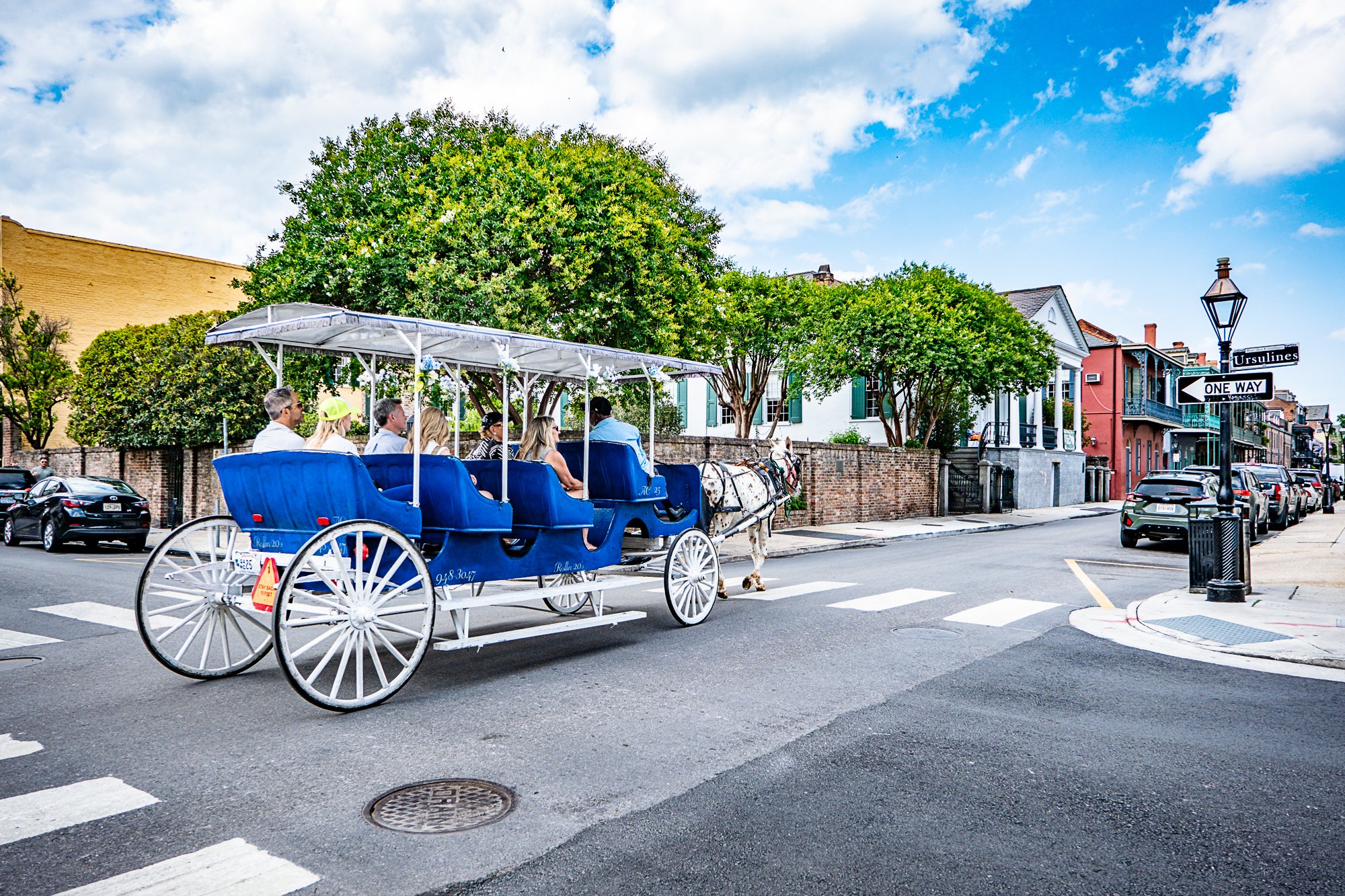
As we leave the Market behind, a mule-drawn carriage clatters by—slow and steady. The driver shares facts like a storyteller on repeat, pointing out history to riders taking in the view. It’s a short ride, but it feels like a shift. A moment to sit back while the city rolls by. We follow its path, easing our way back toward Royal.

Back on Royal, the sound hits before the sight—a street band packed tight on the sidewalk, blasting brass and rhythm into the crowd. They’re funny, loud, and completely in their element. Between songs, one of them jokes they’re playing for beer and weed money. No shame—just truth. It works. Their music fills the street, and the tips keep coming.
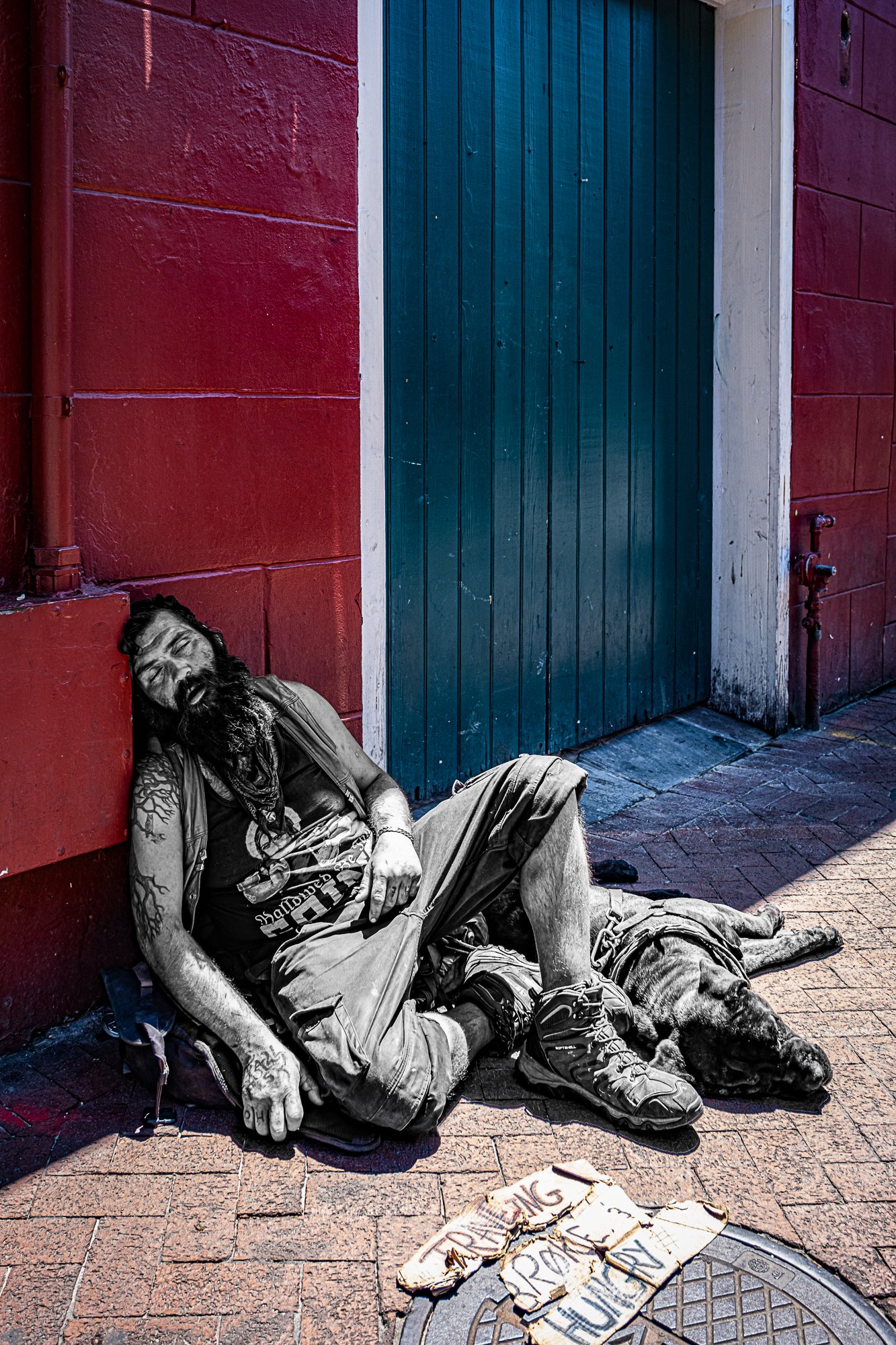
On the edge of a red wall, a man sleeps with his head resting on a box, propped up against a building. His dog is curled beside him, peaceful and still. A cardboard sign reads: traveling, broke, and hungry. People pass without stopping. Some glance. Some don’t. But this moment lingers. In a city so alive, this is someone simply existing.

By evening, the Quarter begins to settle—just a little. Outside Café Beignet, warm light spills onto the sidewalk. A few tables are still full, conversations lingering as powdered sugar floats through the air. The music plays soft and easy, more like memory than performance. It’s not silent, but it’s calm. A sweet pause before the streets buzz again.
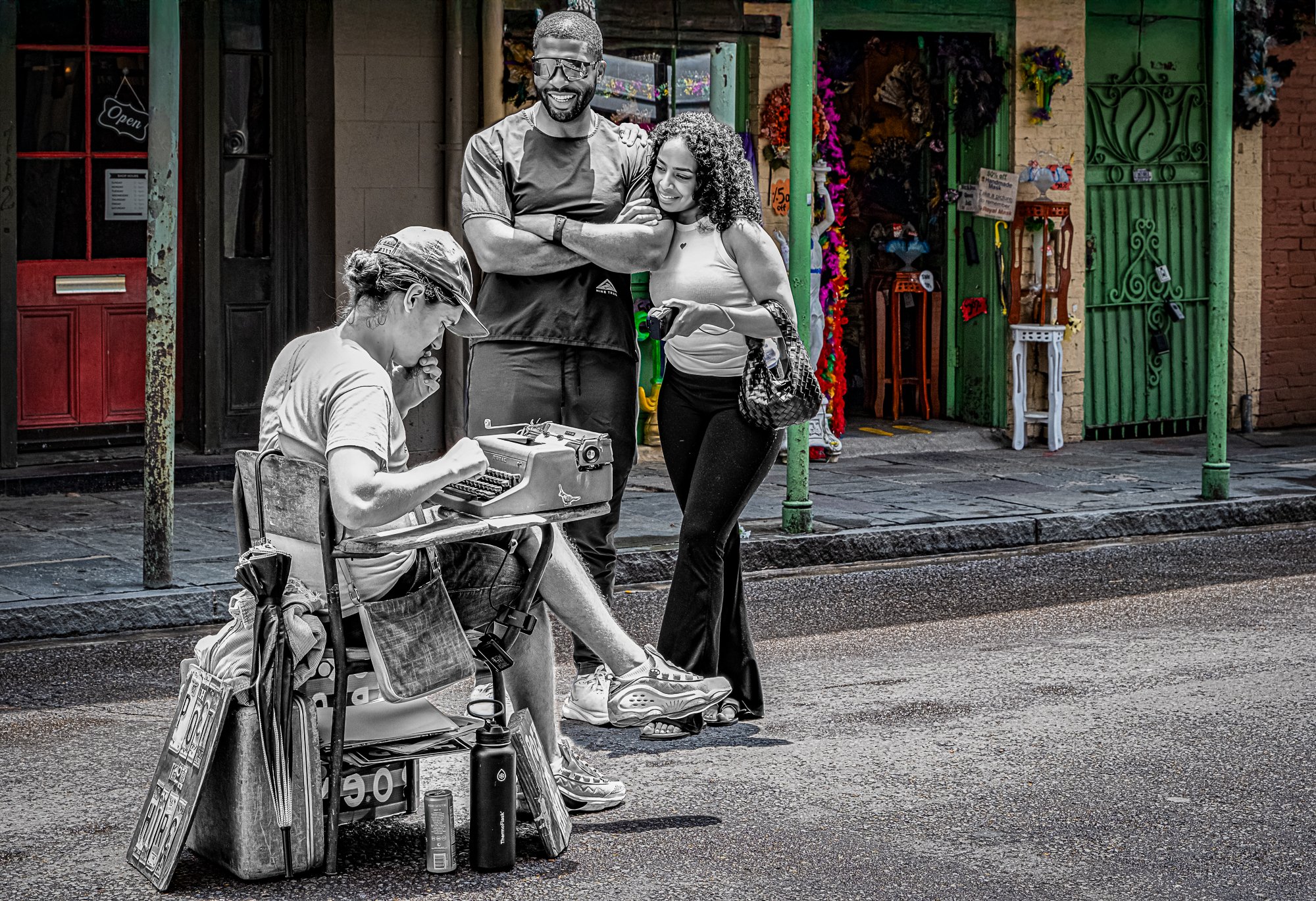
Just up Royal from Café Beignet, a poet sits behind a folding table, performing in his own way—clicking out poems on a vintage typewriter. A man and woman watch, smiling, as he creates something just for them. There’s no mic, no shouting—just the sound of keys and attention. In a city full of big acts, his is quiet, personal, and just as unforgettable.

As we leave Royal and head back toward Bourbon, the pace shifts again. The street starts to swell with people—some strolling, others weaving through with purpose. Music leaks from doorways. Laughter bounces off brick. You can feel the Quarter tightening around you, pulling you back into its rhythm. The crowd is growing. Evening is approaching.

I’d been scanning for beads all day, expecting them to be everywhere—but they weren’t. Then I looked up. A few bright strands hung above me, wrapped across the ironwork of a balcony. Not tangled. Not forgotten. Still brilliant, like they’d been placed there on purpose. In all the movement below, this little detail felt like a quiet, colorful reminder to look up.
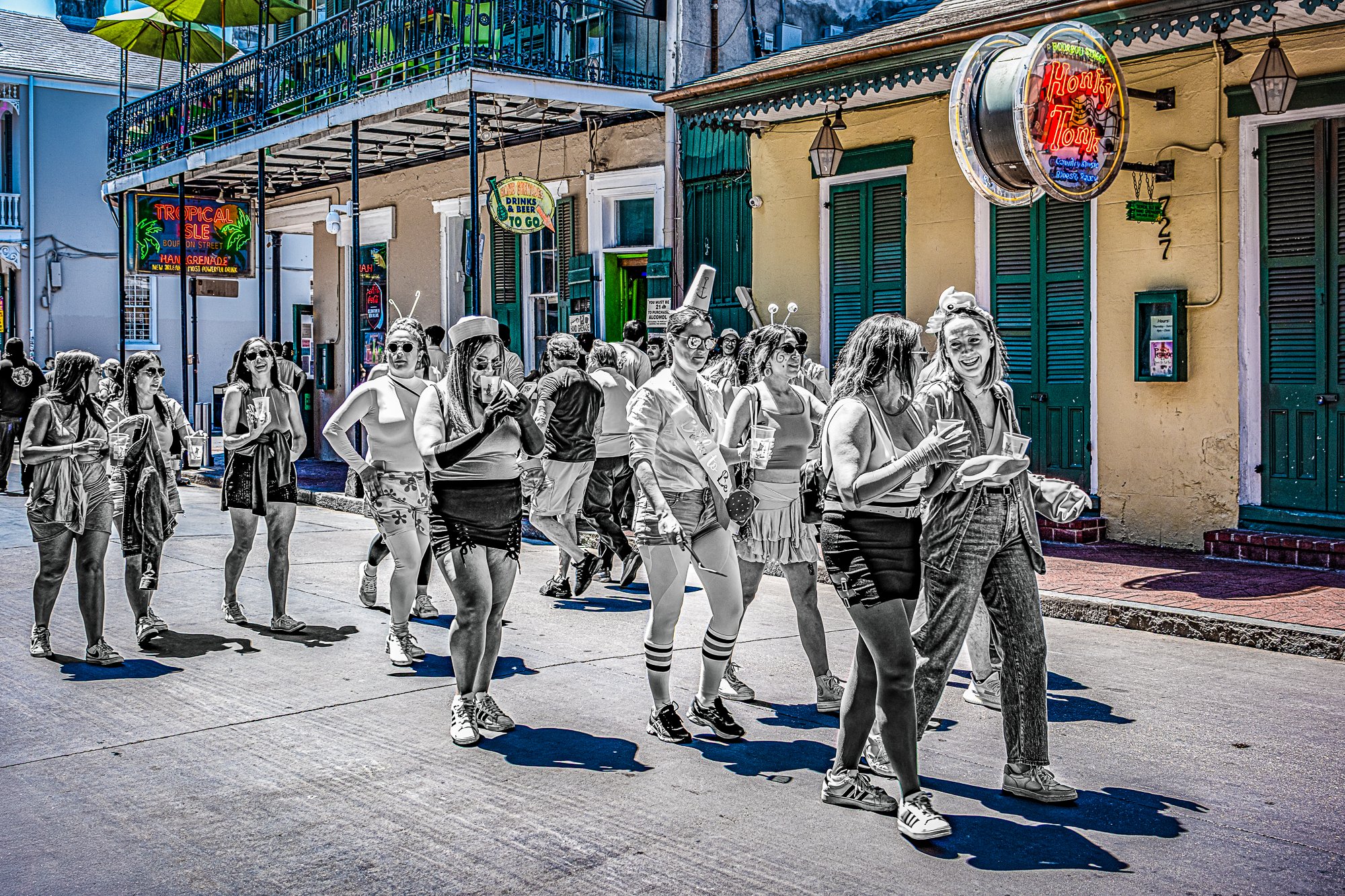
Back on Bourbon, the energy is full tilt again. A bridal party parades through in silly headbands and costumes, laughing louder than the music. They aren’t trying to blend in—no one does here. For a moment, they own the block, and the Quarter joins in without being asked. It’s loud, wild, and exactly the kind of joy this place is built to hold.
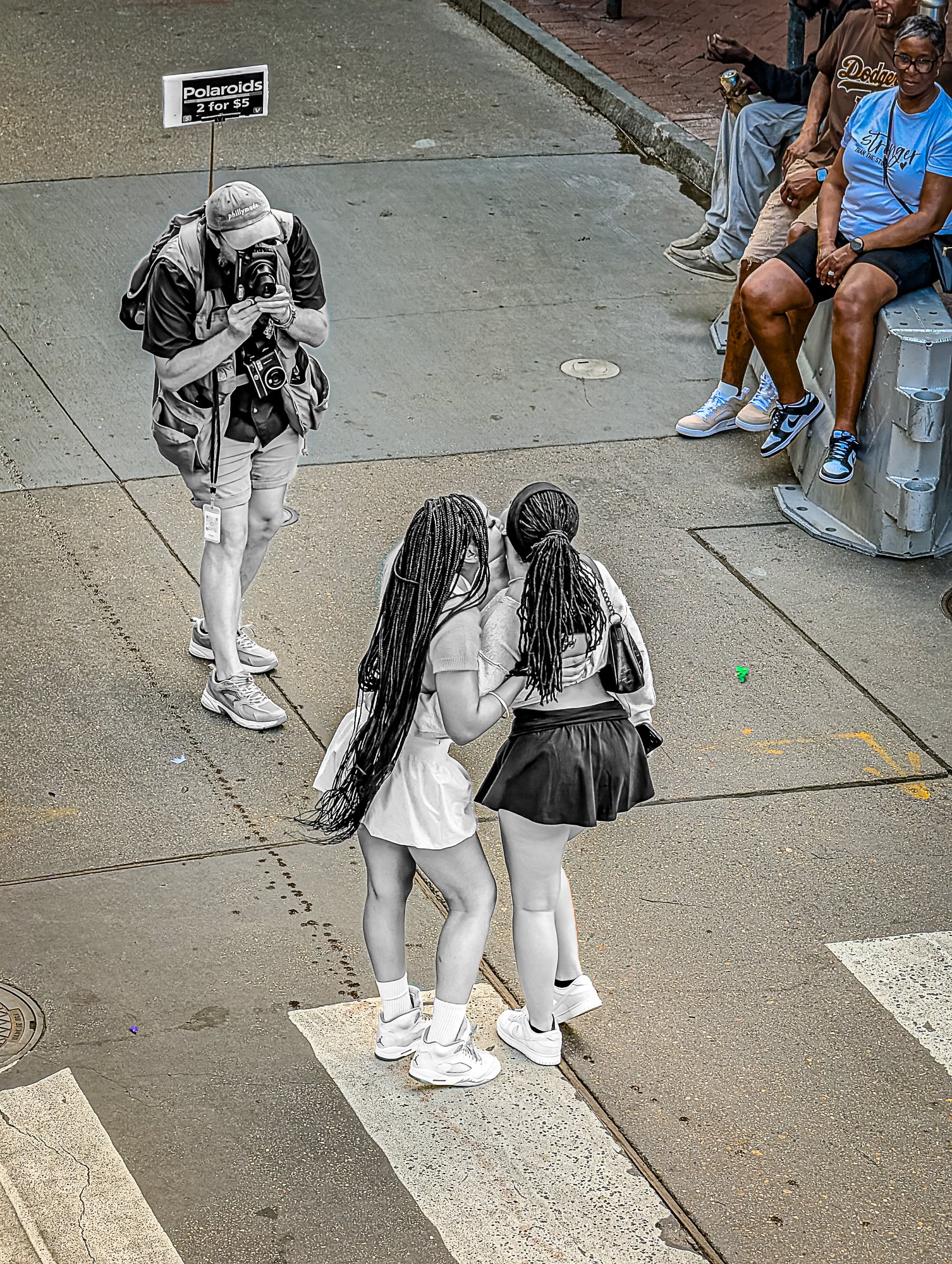
Just off the curb, two girls stop to snap a photo—laughing, posing, lit by the buzz of Bourbon behind them. It’s quick and casual, but intentional. A memento in the making. Maybe it’ll live on their lock screen, or maybe it’ll get buried in a photo dump. Either way, it’s about freezing a feeling they don’t want to forget.
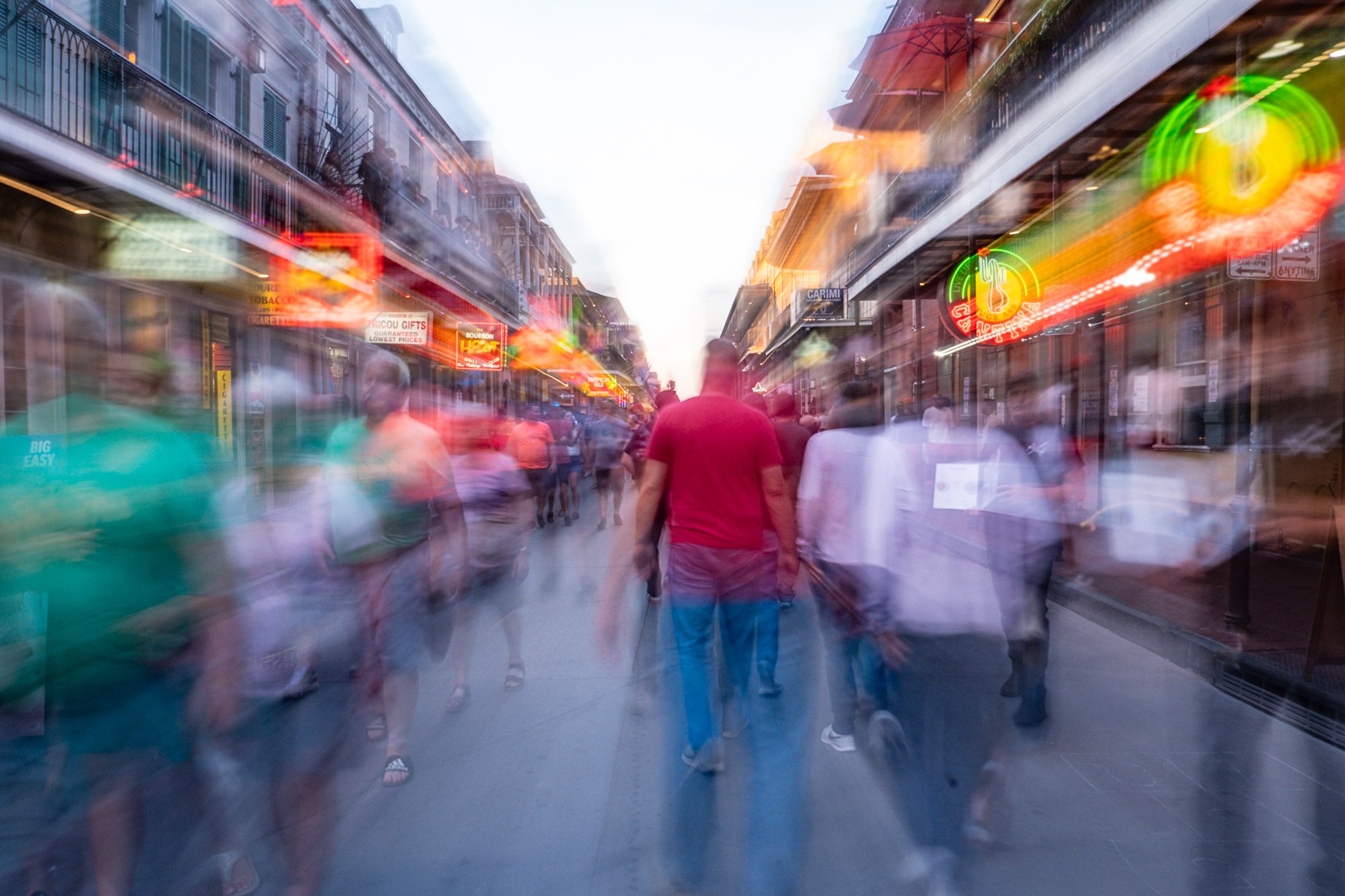
The motion in this last image isn’t a mistake—it’s a truth. By the end, the streets were humming, the people in full swing, everything moving too fast to catch cleanly. That’s what this place does. It builds, it crescendos, and then it keeps going. You don’t leave New Orleans behind—you just step away from it… until the next time it pulls you back in.